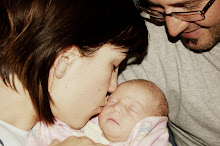After 18 months of questions, concerns and many appointments, a diagnosis came in March '09 when a dedicated and caring pediatrian at the Glenrose Rehabilitation Hospital and a persistent and knowlegable Infectious Disease Specialist at the Stollery Children's hospital worked together to give us an answer to Sienna's hearing loss and developmental and growth delays. They did a never before done test of her newborn blood (which is kept in a lab in Edmonton for the scientist not the doctors), testing for CMV, which came back positive. I have learned alot about this silent and complicated virus and I continue to learn everyday as I encouter new situations. I would like to take this time to share with you what I know about CMV. My knowledge comes mostly from the website Centre for Disease and Control and from the Infectious Disease Specialist at the Stollery Children's Hospital.
- Between 50% and 80% of adults in the United States are infected with CMV by 40 years of age
- CMV is the most common virus transmitted to a pregnant woman's unborn child
- Approximately 1 in 150 children is born with congenital CMV infection
- Approximately 1 in 750 children is born with or develops permanent disabilities due to CMV which is a 0.001% chance that it'll happen to you
- Congenital CMV (meaning present at birth) is as common a cause of serious disability as Down syndrome, fetal alcohol syndrome, and neural tube defects yet nobody knows about it
- CMV is found in body fluids, including urine, saliva (spit), breast milk, blood, tears, semen, and vaginal fluids
- Once CMV is in a person's body, it stays there for life
- Most CMV infections are "silent," meaning they cause no signs or symptoms in an infected person
- Transmission of CMV occurs from person to person, through close contact with body fluids (urine, saliva (spit), breast milk, blood, tears, semen, and vaginal fluids), but the chance of getting CMV infection from casual contact is very small.
- In the United States, about 1%-4% of uninfected mothers have primary (or first) CMV infection during a pregnancy.
- 33% of women who become infected with CMV for the first time during pregnancy pass the virus to their unborn babies.
- CMV is spread from person to person contact (such as, kissing, sexual contact, and getting saliva or urine on your hands and then touching your eyes, or the inside of your nose or mouth)
- Women who are pregnant or planning a pregnancy should follow hygienic practices (e.g., careful handwashing) to avoid CMV infection. Because young children are more likely to have CMV in their urine or saliva (spit) than are older children or adults, pregnant women who have young children or work with young children should be especially careful.
- Vaccines for preventing CMV infection are still in the research and development stage.
PREVENTING CMV DURING PREGNANCY
- Wash your hands often with soap and water for 15-20 seconds, especially after changing diapers or touching saliva or nasal secretions from a young child.
- Reduce contact with saliva and nasal secretions from young children by 1) using soap and water or a disinfectant to clean hard surfaces that have been contaminated by secretions, 2) not sharing food, drinks, or eating utensils with young children, and 3) being careful to limit kissing of young children on the lips.
- If you work in a day care center, limit close contact with children younger than 2½ years of age, especially if you've never been infected with CMV or don't know if you've been infected.
Because Sienna has congenital CMV, she carries the virus and will for the rest of her life. Most of the time the virus is "latent" (i.e. hiding in different cells of the body) and not being excreted. However, from time to time they will shed virus without any symptoms. It can be transmitted by direct contact or contact with a contaminated object, although the highest risk is with repeated direct contact.
Although the risk is extremely low, 0.001% chance, of having a baby born with CMV and permanent disabilities, it happened to me. I am very cautious when Sienna is out especially around pregnant women. This post is to educate pregnant women on the importance of hand-washing even when you are around your own children because they could also be carrying the virus.
Here are other informative links:
Department of Health- New York State
Please pass this message on and help me spread awareness about CMV.








Sienna is so lovely! Thanks for spreading the news about CMV prevention.
ReplyDeleteSincerely,
Lisa Saunders, mom to Elizabeth born disabled by congenital CMV (1989-2006). Story of her life with her big, old dog in memoir, "Anything But a Dog! The perfect pet for a girl with congenital CMV." http://anythingbutadog.blogspot.com/
First off, a small world moment - I was born at the Royal Alex! I've since moved quite far away, but my parents still live right down the street from it.
ReplyDeleteGreat, great post otherwise. I am SO about spreading the word of CMV - I find it just appaling how no one knows about it.
Thanks for this post. Matilda was born with congenital CMV too. She had no symptoms at birth, apart from profound hearing loss. We found out that CMV was the likely cause when her heelprick test was checked at 5 months. Although her development has been fine until now, we're heading down the road of more tests because she hasn't been gaining any weight for a while now.
ReplyDeleteThank you for the information. I really had never heard of it before I started reading Kel's blog, and then yours. I will spread the word. :)
ReplyDeleteHello Jenny, Sienna and family! What a lovely family you have!! We live in Edmonton, Alberta and I stumbled across your blog in my research of CMV. I was told today by my son that his pregnant wife has CMV. I had never heard of it before, I immediately went to the internet to begin researching and was stunned to find out what it could mean for their baby,our unborn grandchild. I have had 3 children of my own and I have never heard of CMV...how could this be? Now that I know, I will make sure I will also spread the word about CMV. As for my grandchild, he is due any day and we can't wait for him to make his grand entrance! We can't wait to shower him with love. We have our faith, and each other, to keep us strong and whatever comes our sweet grandchild's way, he has all the love and support of his family. Thank you Jenny for Sienna's story, and thank you for all the links to continue my education of CMV...
ReplyDelete